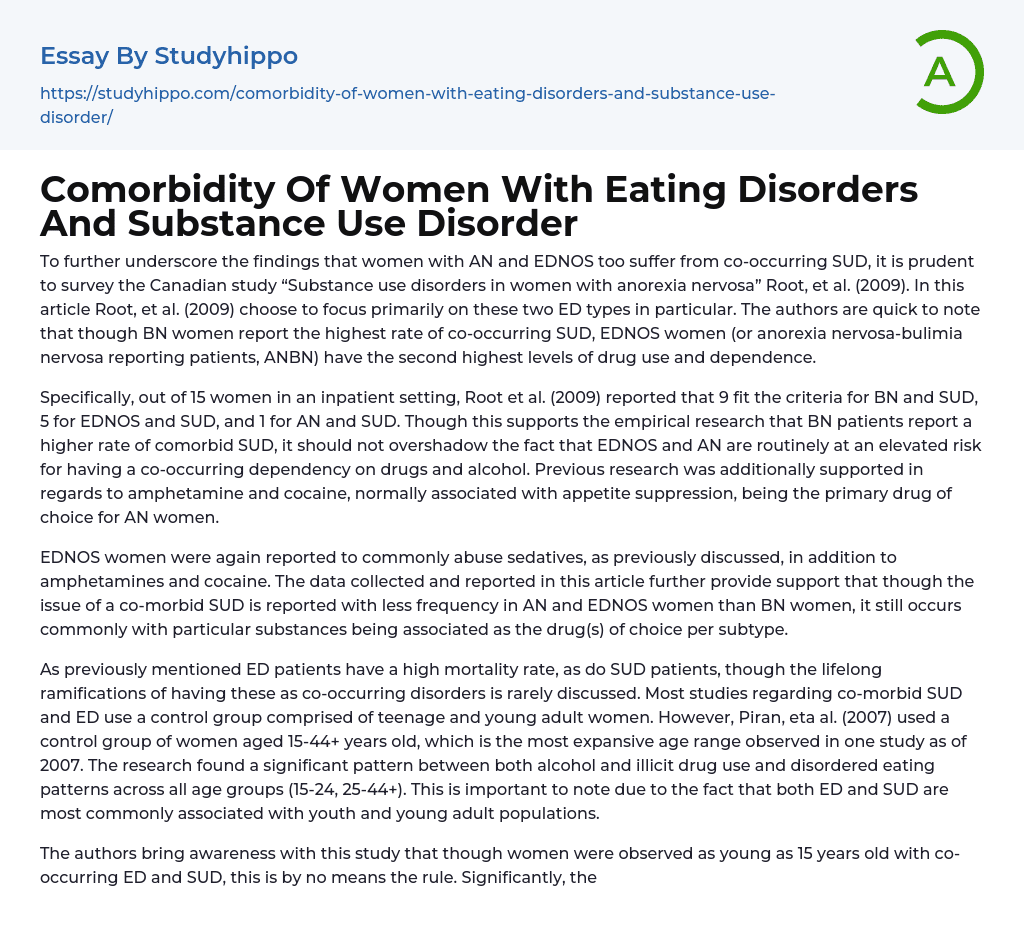

Comorbidity Of Women With Eating Disorders And Substance Use Disorder Essay Example
The study conducted in Canada, titled "Substance use disorders in women with anorexia nervosa" by Root et al. (2009), holds significance as it highlights the previous discoveries that women diagnosed with Anorexia Nervosa (AN) and Eating Disorder Not Otherwise Specified (EDNOS) also experience simultaneous Substance Use Disorders (SUD).
The authors of this article, Root et al. (2009), examine the connection between eating disorders and substance use disorder (SUD). Their study focuses on two specific types of eating disorders: bulimia nervosa (BN) and Eating Disorder Not Otherwise Specified (EDNOS) or patients with both anorexia nervosa and bulimia nervosa (ANBN). The research findings show that women diagnosed with BN have the highest rates of comorbidity with SUD. Similarly, women with EDNOS or ANBN have the second highest rates of drug use and dependence. Root et al.'s study was conducted in a controlled inpati
...ent setting and involved 15 women.
In 2009, a study showed that 9 individuals met the criteria for both Bulimia Nervosa (BN) and Substance Use Disorder (SUD). Additionally, 5 individuals met the criteria for Eating Disorder Not Otherwise Specified (EDNOS) and SUD, while 1 individual met the criteria for Anorexia Nervosa (AN) and SUD. These findings support previous research indicating a higher likelihood of co-occurring SUD in BN patients. However, it is important to note that EDNOS and AN individuals also face an increased risk of simultaneous drug and alcohol dependency. The study also confirmed previous discoveries that AN women often prefer amphetamines and cocaine as these substances are commonly associated with appetite suppression. Furthermore, it was found that EDNOS women frequently misuse sedatives along with amphetamines and cocaine mentioned earlier. Overall, this article's data provides additional
evidence that although co-occurring SUDs are less common in AN and EDNOS women compared to BN women, they still occur frequently—with specific substances being associated with each subtype.
Previous research has shown that individuals with both eating disorders (ED) and substance use disorders (SUD) are at a much higher risk of mortality. However, the long-term effects of having both conditions simultaneously are often overlooked. Many studies examining the co-occurrence of SUD and ED usually include a control group made up of teenage and young adult females. Nonetheless, Piran et al. (2007) conducted a study that included women aged 15 to 44+ years old, which was the most extensive age range analyzed in a single study prior to 2007.
The study found a significant link between alcohol and illicit drug consumption and abnormal eating habits in individuals of all ages (15-24, 25-44+). It is important to note that both eating disorders (ED) and substance use disorders (SUD) are often associated with youth. The authors stress that while young females as young as 15 may display both ED and SUD, this is not always the case. Crucially, the research shows that women aged 15 and above who have an eating disorder are at a significantly higher risk of developing a lifelong substance use disorder.
The study conducted by Piran & Gadalla (2007) found that alcohol abuse and dependence presented a higher risk for young women and adult females, while fully matured adult females had a greater tendency to abuse illegal drugs. Among the control patients, amphetamines and cocaine were frequently abused substances, often accompanied by instances of excessive drinking. This study emphasizes the importance of assessing women with eating disorders
for substance use disorders (SUD), regardless of their age. Conversely, patients displaying symptoms of SUD, particularly if their primary substance of choice is amphetamines, cocaine, or alcohol, may benefit from an evaluation for an eating disorder. When addressing co-occurring disorders, it is crucial to prioritize the treatment of the disorder causing the most immediate distress.
A study conducted by Piran, et al. (2007) explored the adverse outcomes of co-occurring eating disorders (ED) and substance use disorders (SUD). The findings revealed that the negative consequences of ED were more significant than those of SUD in various life domains. Particularly among women, the impact on physical health, perspective on life, and happiness was significantly higher for ED. Acknowledging these difficulties can be advantageous when assessing and treating patients based on the specific areas affected in their lives.
According to Piran et al (2007), women who have both eating disorders (ED) and substance use disorders (SUD) tend to face greater distress and disruption in their lives compared to those with only substance use issues, based on severity criteria. This implies that the adverse consequences experienced by women with co-occurring ED and SUD are more significant. When treating individuals with these conditions, it is important to address the issue that the patient is most motivated to change.



